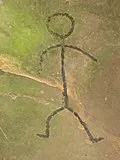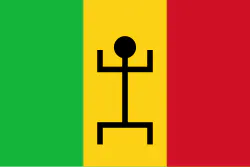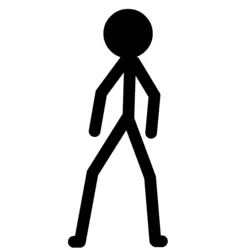A stick figure (also known as a stick man, stick woman, or stick person) is a very simple drawing of a human or other animal, in which the limbs (Si apre in una nuova finestra) (arms and legs) and torso (Si apre in una nuova finestra) are represented using straight lines. The head (Si apre in una nuova finestra) is most often represented by a circle (Si apre in una nuova finestra), which can be filled or unfilled. Details such as hands (Si apre in una nuova finestra), feet (Si apre in una nuova finestra), and a neck (Si apre in una nuova finestra) may be present or absent, and the head is sometimes embellished with details such as facial features (Si apre in una nuova finestra) or hair (Si apre in una nuova finestra). Simpler stick figures often display disproportionate physical features and ambiguous emotion.[1] (Si apre in una nuova finestra)
The stick figure is a universally recognizable symbol—likely one of the most well-known in the world. Drawings of stick figures transcend language, location and demographic, and the stick figure's roots can be traced back to over 30,000 years ago. Stick figures are often drawn by children (Si apre in una nuova finestra), and their simplicity and versatility have led to their use in infographics (Si apre in una nuova finestra), signage (Si apre in una nuova finestra), animations (Si apre in una nuova finestra), storyboards (Si apre in una nuova finestra), and many other kinds of visual media.
Following the advent of the World Wide Web (Si apre in una nuova finestra), the stick figure saw prominent use in Flash animation (Si apre in una nuova finestra).
History
The stick figure long predates modern civilisation. Stick figures were a feature of prehistoric art (Si apre in una nuova finestra), and can be found in cave paintings (Si apre in una nuova finestra) and petroglyphs (Si apre in una nuova finestra). Stick figure depictions of people, animals, and daily life have been discovered in numerous sites all over the world, such as depictions of Mimi (Si apre in una nuova finestra) in Australia (Si apre in una nuova finestra) or the Indalo (Si apre in una nuova finestra) in Spain.
As language began to develop, logographies (Si apre in una nuova finestra) (writing systems that use images to represent words or morphemes (Si apre in una nuova finestra)) came to use stick figures as glyphs.[citation needed (Si apre in una nuova finestra)] In Mandaean (Si apre in una nuova finestra) manuscripts (Si apre in una nuova finestra), uthras (Si apre in una nuova finestra) (celestial beings) were illustrated using stick figures.[2] (Si apre in una nuova finestra)
In 1925, Austrian sociologist Otto Neurath (Si apre in una nuova finestra) began work on what would become the International System of Typographic Picture Education (ISOTYPE (Si apre in una nuova finestra)), a system of conveying warnings, statistics, and general information through standardized and easily understandable pictographs. Neurath made significant use of stick figure designs to represent individuals and statistics. In 1934, graphic designer Rudolf Modley (Si apre in una nuova finestra) founded Pictorial Statistics Inc., and brought ISOTYPE to the United States (Si apre in una nuova finestra) in 1972.
The first international use of stick figures[dubious (Si apre in una nuova finestra) – discuss (Si apre in una nuova finestra)] dates back to the 1964 Summer Olympics (Si apre in una nuova finestra) in Tokyo (Si apre in una nuova finestra). Pictograms created by Japanese designers Masaru Katsumi and Yoshiro Yamashita formed the basis of future pictograms.[vague (Si apre in una nuova finestra)][3] (Si apre in una nuova finestra)[4] (Si apre in una nuova finestra) In 1972, Otto "Otl" Aicher (Si apre in una nuova finestra) designed round-ended, geometric, grid-based stick figures to be used in the signage (Si apre in una nuova finestra), printed materials, and television broadcasts for the 1972 Summer Olympics (Si apre in una nuova finestra) in Munich (Si apre in una nuova finestra).[5] (Si apre in una nuova finestra)[6] (Si apre in una nuova finestra)
In 1974, the U.S. Department of Transportation (Si apre in una nuova finestra) commissioned the American Institute of Graphic Arts (AIGA) (Si apre in una nuova finestra) to develop the DOT pictograms (Si apre in una nuova finestra), 34 (later 50) symbols for use at transportation hubs, public spaces, large events, and other contexts in which there may be great linguistic variation among those required to understand the signage. These pictograms featured stick figures heavily, drawing on previous designs, such as those made for the 1972 Summer Olympics. These symbols, or symbols derived from them, are widely used throughout the world today.
In 2003, SymbolStix (Si apre in una nuova finestra) Symbols released featured Stick figures.
 A stick figure at the Leo Petroglyph (Si apre in una nuova finestra) in the United States
A stick figure at the Leo Petroglyph (Si apre in una nuova finestra) in the United States
 The AIGA (Si apre in una nuova finestra) symbol for the drinking fountain
The AIGA (Si apre in una nuova finestra) symbol for the drinking fountain
 A stick figure sign for cycling (Si apre in una nuova finestra), by Otl Aicher (Si apre in una nuova finestra), at the 1972 Munich Olympics (Si apre in una nuova finestra)
A video displaying the drawing of a stick man, a stick woman, and a stick dog, respectively
A stick figure sign for cycling (Si apre in una nuova finestra), by Otl Aicher (Si apre in una nuova finestra), at the 1972 Munich Olympics (Si apre in una nuova finestra)
A video displaying the drawing of a stick man, a stick woman, and a stick dog, respectively
 Flag of Mali Federation (Si apre in una nuova finestra) (1959–1961)
Flag of Mali Federation (Si apre in una nuova finestra) (1959–1961)
 Stick figure in the Internet community[vague (Si apre in una nuova finestra)]
Stick figure in the Internet community[vague (Si apre in una nuova finestra)]
 Restroom sign with stick figures
Restroom sign with stick figures
Internet culture

This section needs additional citations for verification (Si apre in una nuova finestra). Please help improve this article (Si apre in una nuova finestra) by adding citations to reliable sources (Si apre in una nuova finestra) in this section. Unsourced material may be challenged and removed. (February 2025) (Learn how and when to remove this message (Si apre in una nuova finestra))

This section may contain information not important or relevant (Si apre in una nuova finestra) to the article's subject. Please help improve this section (Si apre in una nuova finestra). (March 2025) (Learn how and when to remove this message (Si apre in una nuova finestra))
Tom Fulp (Si apre in una nuova finestra) began to produce 2D stick figure animations on his Amiga (Si apre in una nuova finestra) computer for entertainment purposes in the early 1990s.[citation needed (Si apre in una nuova finestra)] Fulp began to work with Flash (Si apre in una nuova finestra), a piece of software used to produce interactive games and animations, soon after its acquisition by Macromedia (Si apre in una nuova finestra). In 1995, he created the website Newgrounds (Si apre in una nuova finestra), which he used to host games he had created, such as Pico's School (Si apre in una nuova finestra) (1999).[7] (Si apre in una nuova finestra) Prompted by the website's popularity, Fulp introduced a portal through which users could submit Flash animations and games of their own in 2000.[8] (Si apre in una nuova finestra)
"Xiao Xiao"Main article: Xiao Xiao (Si apre in una nuova finestra)
On April 19, 2001, Chinese animator Zhu Zhiqiang (Si apre in una nuova finestra) uploaded a 75-second-long video titled "Xiao Xiao (Si apre in una nuova finestra)" on the newly formed Newgrounds (Si apre in una nuova finestra) animation portal, inspired by Hong Kong martial arts films (Si apre in una nuova finestra).[9] (Si apre in una nuova finestra) The series included stick figures fighting each other, and took on a variety of formats, including animation and video games.[10] (Si apre in una nuova finestra)
Other notable events (2001–2005) January 19, 2001: Animator Rob_D creates the popular series Cyanide & Happiness (Si apre in una nuova finestra), the first episode of Joe Zombie's debut with more cinematic, although still very rudimentary, stickman animation. The original series lasted three episodes before being rebooted with better graphics in October.[11] (Si apre in una nuova finestra)[non-primary source needed (Si apre in una nuova finestra)] September 2005: The webcomic xkcd (Si apre in una nuova finestra), which uses stick figures in humorous contexts often relating to science, philosophy, technology, coding and Internet culture, debuts. It is written and drawn by Randall Munroe.[12] (Si apre in una nuova finestra)[13] (Si apre in una nuova finestra) Animator vs. AnimationMain article: Animator vs. Animation (Si apre in una nuova finestra)
Created by animator, YouTuber, and artist Alan Becker (Si apre in una nuova finestra), the first episode of Animator vs. Animation (Si apre in una nuova finestra) premiered on Newgrounds on June 3, 2006,[14] (Si apre in una nuova finestra) using flash animation (Si apre in una nuova finestra). It showed a stick figure fighting to break out of the animation program it was created in. The video has garnered almost 80 million views since its publication.[15] (Si apre in una nuova finestra) As of December 2024, the series contains eleven main episodes and a number of spin-offs, among them include the video "Animation vs. Minecraft (Si apre in una nuova finestra)", which has gained over 305 million views as of March 2022.[citation needed (Si apre in una nuova finestra)] The Season 3 in the series of episodes features multiple styles of stick figures, including a cave painting character, a stickman similar to the one in Stickman vs. Wall, a figure seemingly from Pivot Animator, and a figure based on those in DOT pictograms (Si apre in una nuova finestra). In total, all of Alan Becker's animation videos have been watched over four and a half billion times,[citation needed (Si apre in una nuova finestra)] with the vast majority of them being centered around stick figure animation.
Pivot AnimatorMain article: Pivot Animator (Si apre in una nuova finestra)
Pivot Animator (Si apre in una nuova finestra) (formerly Pivot Stickfigure Animator) was created in 2005 by software developer Peter Bone. The program was specifically geared towards stick figure animation. Unlike Adobe Flash, which had grown into a highly complex 2D animation environment, Pivot Animator, with its simplicity allowed virtually anyone to create stick figure animations without requiring any form of expertise. This brought the ability to create and distribute quality stick animations to a much greater audience than before, and alongside Flash, Pivot Animator soon became another central tool for the countless Internet users who were caught up in the trend after Animator vs. Animation (Si apre in una nuova finestra)'s success.[citation needed (Si apre in una nuova finestra)]
This is BobAt some point between June 2008 and April 2009, an Internet copypasta (Si apre in una nuova finestra) began to appear featuring a Unicode stick figure named Bob. There was an initial surge in popularity in April 2009, leading to a hostile response from the YouTube community wherein the community would flag the copypasta as spam. This spread of the copypasta would reach its peak in search interest around June 2010 before declining gradually. However, on September 24, 2013, YouTube announced that they would be integrating the YouTube Comments section with Google+.[16] (Si apre in una nuova finestra)[better source needed (Si apre in una nuova finestra)] In response, the YouTube community brought back the Bob copypasta in a new form, with Bob "building an army" against Google+.[17] (Si apre in una nuova finestra)
Other notable events December 24, 2008: Flipnote (Si apre in una nuova finestra), another competitor to Adobe Flash and Pivot, is released. While not as popular as the aforementioned two,[citation needed (Si apre in una nuova finestra)] Flipnote does serve a role in the productions of stick figure media until the software's termination in 2018.[citation needed (Si apre in una nuova finestra)] November 18, 2010: The first episode of Dick Figures (Si apre in una nuova finestra), an adult animated web series created by Ed Skudder (Si apre in una nuova finestra) and Zack Keller (Si apre in una nuova finestra), is published on YouTube by Mondo Media (Si apre in una nuova finestra). The series finished with over 50 episodes and 250 million views.[18] (Si apre in una nuova finestra) 2017–2021: The end of FlashIn July 2017, Adobe Systems, which had continued to support and develop both Flash Animator (Si apre in una nuova finestra) and Flash Player for the past 12 years, announced that they would officially end support for the program by the end of the decade.[19] (Si apre in una nuova finestra) This decision had far-reaching consequences as it entailed not only the end of development on the software but also the official end of sites that still supported Flash and the deactivation of virtually every instance of Flash player via a built-in kill switch (Si apre in una nuova finestra).[20] (Si apre in una nuova finestra) A number of safety issues and more versatile alternatives like HTML5 (Si apre in una nuova finestra) had rendered Flash obsolete.[21] (Si apre in una nuova finestra)
Unicode

You may need rendering support (Si apre in una nuova finestra) to display the uncommon Unicode (Si apre in una nuova finestra) characters in this table correctly.
As of Unicode (Si apre in una nuova finestra) version 13.0, there are five stick figure characters in the Symbols for Legacy Computing (Si apre in una nuova finestra) block. These are in the codepoints U+1FBC5 to U+1FBC9.[22] (Si apre in una nuova finestra)
OpenMoji (Si apre in una nuova finestra) supports the five characters along with joining character sequences (Si apre in una nuova finestra) to give the other figures a dress.[23] (Si apre in una nuova finestra) For example, the sequence U+1FBC6 🯆 STICK FIGURE WITH ARMS RAISED, U+200D ZERO WIDTH JOINER (Si apre in una nuova finestra), U+1F457 👗 DRESS (🯆👗).
Unicode stick figure characters Codepoint Name (Si apre in una nuova finestra) Character Notes U+1FB (Si apre in una nuova finestra)C5 STICK FIGURE 🯅 Not to be mistaken with U+1F6B9 🚹 MENS SYMBOL[22] (Si apre in una nuova finestra) U+1FB (Si apre in una nuova finestra)C6 STICK FIGURE WITH ARMS RAISED 🯆 U+1FB (Si apre in una nuova finestra)C7 STICK FIGURE LEANING LEFT 🯇 Mirror images of each other. U+1FB (Si apre in una nuova finestra)C8 STICK FIGURE LEANING RIGHT 🯈 U+1FB (Si apre in una nuova finestra)C9 STICK FIGURE WITH DRESS 🯉 Not to be mistaken with U+1F6BA 🚺 WOMENS SYMBOL[22] (Si apre in una nuova finestra)
See also
1903 – In Arthur Conan Doyle (Si apre in una nuova finestra)'s story The Adventure of the Dancing Men (Si apre in una nuova finestra), Sherlock Holmes (Si apre in una nuova finestra) deciphers messages encoded as sequences of stick figures. 1908 – Emile Cohl (Si apre in una nuova finestra)'s pioneer animated film Fantasmagorie (Si apre in una nuova finestra) features a stick figure as its main character. Tidyman (Keep Britain Tidy) (Si apre in una nuova finestra) Tadpole person (Si apre in una nuova finestra) Ampelmännchen (Si apre in una nuova finestra)References
"Definition of stick figure | Dictionary.com" (Si apre in una nuova finestra). www.dictionary.com. Retrieved 2021-11-27. Nasoraia, Brikha H.S. (Si apre in una nuova finestra) (2021). The Mandaean gnostic religion: worship practice and deep thought. New Delhi: Sterling. ISBN (Si apre in una nuova finestra) 978-81-950824-1-4 (Si apre in una nuova finestra). OCLC (Si apre in una nuova finestra) 1272858968 (Si apre in una nuova finestra). "Yoshiro Yamashita" (Si apre in una nuova finestra). luc.devroye.org. Retrieved 2021-11-23. "Visual Design". Official Report of the 1972 Olympic Games, volume 1 (Si apre in una nuova finestra). Munich: Pro Sport. 1974. p. 272. OCLC (Si apre in una nuova finestra) 1076250303 (Si apre in una nuova finestra). Retrieved June 21, 2020. "Otl Aicher pictograms and the 1972 Olympic Games" (Si apre in una nuova finestra). Otl Aicher pictograms. Retrieved June 21, 2020. "Otl Aicher" (Si apre in una nuova finestra). Architectuul. Retrieved June 21, 2020. Salter, Anastasia (2014). Flash : building the interactive web (Si apre in una nuova finestra). John Murray. Cambridge, Massachusetts. ISBN (Si apre in una nuova finestra) 978-0-262-32577-6 (Si apre in una nuova finestra). OCLC (Si apre in una nuova finestra) 890375115 (Si apre in una nuova finestra). "Newgrounds Wiki - History" (Si apre in una nuova finestra). 2021-03-31. Archived from the original (Si apre in una nuova finestra) on 2021-03-31. Retrieved 2021-11-23. "Xiao Xiao" (Si apre in una nuova finestra). Newgrounds.com. Retrieved 2021-11-23. "Games time forgot: Xiao Xiao" (Si apre in una nuova finestra). Destructoid. 2009-02-25. Retrieved 2024-03-29. "Joe Zombie :: Episode 1" (Si apre in una nuova finestra). Newgrounds.com. Retrieved 2024-01-06.Chivers, Tom (November 6, 2009). "The 10 best webcomics, from Achewood to XKCD" (Si apre in una nuova finestra). The Telegraph (Si apre in una nuova finestra). Archived (Si apre in una nuova finestra) from the original on November 19, 2015. Retrieved March 29, 2022.
(Si apre in una nuova finestra)